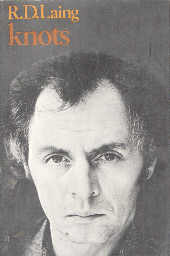They are not having fun.
I can't have fun if they don't.
If I get them to have fun, then I can have fun with them.
Getting them to have fun, is not fun. It is hard work.
I might get fun out of finding out why they're not.
I'm not supposed to get fun out of working out why
they're not.
But there is even some fun in pretending to them I'm not
having fun finding out why they're not.
A little girl comes along and says: let's have fun.
But having fun is a waste of time, because it doesn't
help to figure out why they're not having fun.
How dare you have fun when Christ died on the Cross
for you! Was He having fun?
After a dozen or so preparatory knots involving individuals, Laing devotes a major
part of the book to knots involving a couple from the famous nursery rhyme, Jack and Jill.
That short verse can be considered to be a metaphor for a married couple's life before entering
therapy. For those not familiar with the rhyme or the pattern it describes, you single ones, it goes like this:
Jack and Jill went up the hill to fetch a pail of water.
Jack fell down and broke his crown and Jill came tumbling after.
Jack and Jill decided to get married. As they left the altar, they had a goal in mind.
It might have been to raise a family, but metaphorically the goal could be expressed as
fetching a pail of water. Along the way, one of them falls down and the other tumbles soon
after. One of them begins a knot and the other gets quickly entwined. They go to the knot-un-tier, a therapist, and tell their story.
[page 21]
JILL I'm upset you are upset
JACK I'm not upset
JILL I'm upset that you're not upset that I'm upset that you're upset.
JACK I'm upset that you're upset that I'm not upset that you're upset
that I'm upset, when I'm not.
JILL You put me in the wrong
JACK I am not putting you in the wrong
JILL You put me in the wrong for thinking you put me in the wrong.
JACK Forgive me
JILL No
JACK I'll never forgive you for not forgiving me
This "Jack and Jill" knot, which pervades the book, seems to go on forever, and
without a competent therapist's assistance, perhaps it will. The introduction to Knot 3 is a
meta-knot, if you will, a knot at the highest level of abstraction, that deals with so many
aspects of life that it is worth putting on a bumper sticker, in an email signature file, on a
business card, or reciting as a daily mantrum:
If I don't know I don't know, I think I know
If I don't know I know, I think I don't know
Usually, when we speak a sentence with a "not" in it, our human mind
creates an image of the sentence's meaning by dropping the "not" out of the sentence. There is no image associated with the word "not." This was
hammered home in their early seminars by Bandler and Grinder. They would tell someone
in the seminar, "Joe, don't think of a pink elephant." Then later they would ask Joe, "What
color was the pink elephant?" Everyone got the message. Whenever we talk, we create
images from our words, but there is no image for "not." Well, there is one image that I got
from Jonathan Parker: he says when you have a thought you don't want, then take the
image of the thought and place circle around it with a diagonal slash across it like in the No
Right Turn signs, etc. Notice how I've placed the thought of a "right turn" into your minds
by my choice of example. I did it consciously. Even more effective speakers and writers
than I am do their choices of examples unconsciously - they don't know they know how
to do this, so they think they don't know how.
The other kind of person is one who thinks they know because they don't know they
don't know. These persons, who profess knowledge but don't know they don't know,
represents the vast majority of humanity, up until now. This type of semantic hubris tends
especially to infect those who frequent the halls of academe. They have prestigious degrees
and know a lot about many things, but many of them are not able to freely admit that much of what they think they know is only possible because of the things they don’t know they don’t know, so they think they know, up until now.
~^~
---------------------------- Footnotes -----------------------------------------
Footnote 1.
A disjunctive conjunction is defined by Cassel's Concise Dictionary as: a conjunction (e.g.
or, but, though) which unites sentences or clauses in composition, but divides them in sense,
as opposed to a copulative conjunction. Knots, in marriage, unite two partners as a couple in composition, but separate them in the disjunctive sense, as opposed to the more
enjoyable copulative sense.
Return to text directly before Footnote 1.
~~~~~~~~~~~~~~~~~~~~~~~~~~~~~~~~~~~~~~~~~~~~~~
~^~
Any questions about this review, Contact: Bobby Matherne
~~~~~~~~~~~~~~~~~~~~~~~~~~~~~~~~~~~~~~~~~~~~~~~~~~~~~~~~~~




